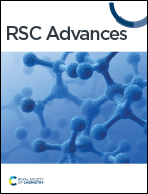Kinetic study of NADPH activation using ubiquinone-rhodol fluorescent probe and an IrIII-complex promoter at the cell interior
Abstract
Nicotine adenine dinucleotide derivatives NADH and NADPH are intimately involved in energy and electron transport within cells. The fluorescent ubiquinone-rhodol (Q-Rh) probe is used for NADPH activation monitoring. Q-Rh reacts with NADPH yielding its quenched hydroquinone-rhodol (H2Q-Rh) form with concurrent NADPH activation (i.e. NADP+ formation). NADPH activation can be enhanced by the addition of an IrIII-complex (i.e. [(η5-C5Me5)Ir(phen)(H2O)]2+) as a promoter. The rate of the Q-Rh fluorescence quenching process is proportional to the NADPH activation rate, which can be used to monitor NADPH. Experiments were performed in phosphate-buffered saline (PBS) solution and on HeLa cell cultures to analyze the kinetics of Q-Rh reduction and the influence of the IrIII-complex promoter on the activation of NADPH (in PBS) and of other intracellular reducing agents (in HeLa cells). There is a substantial increase in Q-Rh reduction rate inside HeLa cells especially after the addition of IrIII-complex promoter. This increase is partly due to a leakage process (caused by IrIII-complex-induced downstream processes which result in cell membrane disintegration) but also involves the nonspecific activation of other intracellular reducing agents, including NADH, FADH2, FMNH2 or GSH. In the presence only of Q-Rh, the activation rate of intracellular reducing agents is 2 to 8 times faster in HeLa cells than in PBS solution. When both Q-Rh and IrIII-complex are present, the rate of the IrIII-complex catalyzed reduction reaction is 7 to 23 times more rapid in HeLa cells. Concentration- and time-dependent fluorescence attenuation of Q-Rh with third-order reaction kinetics (reasonably approximated as pseudo-first-order in Q-Rh) has been observed and modelled. This reaction and its kinetics present an example of “bioparallel chemistry”, where the activation of a molecule can trigger a unique chemical process. This approach stands in contrast to the conventional concept of “bioorthogonal chemistry”, which refers to chemical reactions that occur without disrupting native biological processes.



 Please wait while we load your content...
Please wait while we load your content...